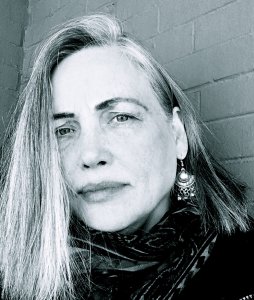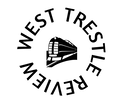When a painting's not working it's at its most exciting juncture. Part of your brain wants to to run away. The other part wants to tear up the map and re-route. ~Rebecca Pyle
Maybe because Rebecca Pyle is a writer in addition to being an artist, her paintings — oil on canvas and oil and acrylic on canvas — seem to draw the viewer in and tell a mysterious story. It's a choose-your-own-adventure kind of tale, where the viewer gazes at the painting so long that she has to shake herself loose from its bright and wobbly grasp and remind herself of what's real. As Pyle suggests in this interview, there does seem to be something hidden in each painting, like the kiss in the corner of Mrs. Darling's mouth, something magic that's just out of reach. This tension allows these paintings to complement our contributors' texts in fascinating and lively ways. I hope you enjoy this interview with Pyle as much as I do. ~Patricia Caspers
Patricia Caspers: You are a writer as well as an artist, and I read that you love fairytales. Are there ways you bring fairytales into your visual art?
Rebecca Pyle: Could it be true that in almost every painting, if it's brave/successful, there is a suggested thicket, or glass mountain, or almost unfindable place which the hero, or heroine, has found? Even if the painting does not provide the way through, the way across, or any other directions, it represents a challenge already met, at least partially. I think.
I'm trying to think of paintings which someone might suggest none of those could apply to. And can't. Even a modern canvas painted purely one color. (What banished the other colors? Can a person learn from or escape from the enclosure of this one solitary color? Should one? How?) (Is that one block of color the expression of the soul of one person? Is that color part of the answer of a riddle? And so on ...) But then again, I'm a bit odd.
PC: I love the idea that the viewer of a piece of art is seeing a glimpse into a hero or heroine's journey!
In your essay, "Two Lions, and a Tea Cupboard" in Common Ground Review you write, "Cutting a puppet string, breaking a rule, is what matters: it begins good writing, good art." In what ways do you cut puppet strings in your art?
RP: I think (without usually even being aware, anymore) I start by imagining what the easy and common depictions of something (an idea, a person, an emotion) are. Popular and common depictions, as advertisers know, lull people into a sort of anesthetized state. Fighting your way free, as a painter, is a proud energy, a fuel which can start and even completely sustain a painting session.
Yes, you've caught exactly what I mean -- the struggle of the hero/heroine. Spontaneously doing the unexpected, off-kilter, without apology. Choosing surprising directions: sometimes their greatest strength is being completely unafraid of looking lost or foolish. (A painter certainly is that way again and again: lots of dizzy, hunting, blundering innocence, leading the way.)
PC: This question is in three parts: I can't imagine that it's easy to cut puppet strings — to subvert expectations. When do you know that a painting is successful? How does an artist cultivate the self-confidence to trust his / her / their artistic instincts, especially when they are outside the mainstream? And what is your relationship to failure? In other words, are there times when a piece is not successful, and where do you go from there?
RP: When a painting's not working it's at its most exciting juncture. Part of your brain wants to to run away. The other part wants to tear up the map and re-route. You blame your weary brain for going at the project too timidly.
Maybe a painting is a bit like a train. A train trip. A painting which has not succeeded has not taken you anywhere. It stayed at the station and brooded mildly but did not care much. The one you like has travelled, and you feel different because you saw things, in your head, felt things, in your head, as you painted, which are leaving you with a happy, startled, feeling of arrival. At last. And, maybe, the feeling you've left things behind which needed to be left behind. Your head is clear. The colors fell where they should.
Something else I would add is an artist's memory of painting in a large group — in group studios, as a student — leaves many, myself included, so grateful to be completely alone, as you paint. Most painters, I think, look startled to see their paintings surrounded by people. At a show. They were, once, so alone with each other: painter and painting.
PC: I love that you've ended a West Trestle interview with a train metaphor as well as the perfect description of what I feel -- maybe many most writers feel — when their texts are out in the wild, reaching readers: startled. Thank you!
Rebecca Pyle: Could it be true that in almost every painting, if it's brave/successful, there is a suggested thicket, or glass mountain, or almost unfindable place which the hero, or heroine, has found? Even if the painting does not provide the way through, the way across, or any other directions, it represents a challenge already met, at least partially. I think.
I'm trying to think of paintings which someone might suggest none of those could apply to. And can't. Even a modern canvas painted purely one color. (What banished the other colors? Can a person learn from or escape from the enclosure of this one solitary color? Should one? How?) (Is that one block of color the expression of the soul of one person? Is that color part of the answer of a riddle? And so on ...) But then again, I'm a bit odd.
PC: I love the idea that the viewer of a piece of art is seeing a glimpse into a hero or heroine's journey!
In your essay, "Two Lions, and a Tea Cupboard" in Common Ground Review you write, "Cutting a puppet string, breaking a rule, is what matters: it begins good writing, good art." In what ways do you cut puppet strings in your art?
RP: I think (without usually even being aware, anymore) I start by imagining what the easy and common depictions of something (an idea, a person, an emotion) are. Popular and common depictions, as advertisers know, lull people into a sort of anesthetized state. Fighting your way free, as a painter, is a proud energy, a fuel which can start and even completely sustain a painting session.
Yes, you've caught exactly what I mean -- the struggle of the hero/heroine. Spontaneously doing the unexpected, off-kilter, without apology. Choosing surprising directions: sometimes their greatest strength is being completely unafraid of looking lost or foolish. (A painter certainly is that way again and again: lots of dizzy, hunting, blundering innocence, leading the way.)
PC: This question is in three parts: I can't imagine that it's easy to cut puppet strings — to subvert expectations. When do you know that a painting is successful? How does an artist cultivate the self-confidence to trust his / her / their artistic instincts, especially when they are outside the mainstream? And what is your relationship to failure? In other words, are there times when a piece is not successful, and where do you go from there?
RP: When a painting's not working it's at its most exciting juncture. Part of your brain wants to to run away. The other part wants to tear up the map and re-route. You blame your weary brain for going at the project too timidly.
Maybe a painting is a bit like a train. A train trip. A painting which has not succeeded has not taken you anywhere. It stayed at the station and brooded mildly but did not care much. The one you like has travelled, and you feel different because you saw things, in your head, felt things, in your head, as you painted, which are leaving you with a happy, startled, feeling of arrival. At last. And, maybe, the feeling you've left things behind which needed to be left behind. Your head is clear. The colors fell where they should.
Something else I would add is an artist's memory of painting in a large group — in group studios, as a student — leaves many, myself included, so grateful to be completely alone, as you paint. Most painters, I think, look startled to see their paintings surrounded by people. At a show. They were, once, so alone with each other: painter and painting.
PC: I love that you've ended a West Trestle interview with a train metaphor as well as the perfect description of what I feel -- maybe many most writers feel — when their texts are out in the wild, reaching readers: startled. Thank you!
Gallery

Rebecca Pyle lives on what was once the lakebed of the then-greater Great Salt Lake. Her writing (poetry, fiction, essays, reviews) and artwork are in numerous art/literary journals and reviews and chapbooks published in the United States, Hong Kong, India, Germany, England, Belgium, Austria, France, Ireland, Northern Ireland. See Rebecca Pyle’s Poets & Writers profile.
|
Powered by Women
